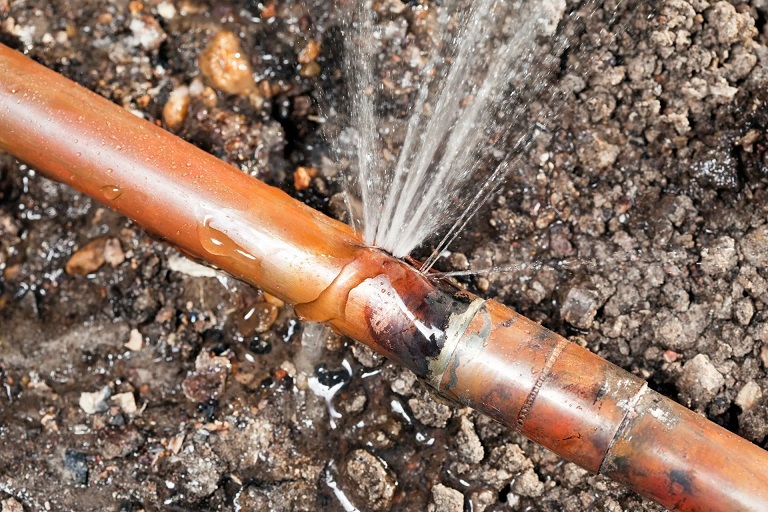Gatineau pipes encounter freezing and leak conditions during the winter season. The problem demands immediate resolution because neglecting this situation might result in foundational wall-floor collapses and potential structural home damage. This article provides instructions for detecting winter pipe leaks, emergency response procedures, and future prevention techniques.
How do you know if a pipe is leaking?
Leaks remain hard to detect because they occur in areas such as behind walls, beneath flooring, and in basement spaces. Here are some signs to look out for:
Reduced water pressure: If you turn on the tap and the water flows less than usual, there may be a leak somewhere in the system.
Unexpected wet spots: Wet spots appear unexpectedly on walls, ceilings, and floors, mostly in colder house areas, and often signal pipe leakage.
Unusual noises in the pipes: Uncommon pipe noises such as hissing or gurgling indicate water escaping through minute pipe fractures even when water is not flowing.
Increased water bills: A sudden increase in your water bill without explanation likely indicates hidden water leakage in your system.
A frozen yet unfaulted pipe will reveal signs of ice or frost accumulation on its exterior.
What do you do if you have a leaking pipe in winter?
- Turn off the water supply
Turn off your house’s water supply first when you spot any leak to prevent additional damage. The water supply cutoff valve is either by the water meter or inside the basement. Investigate and locate the pipe now to prevent emergencies from arising when you need quick access to it.
- Eliminate the source of freezing
If the pipe is frozen, it must be warmed up to avoid further ruptures. Use a hair dryer, a towel soaked in warm water, or a heater (but never an open flame – it is dangerous!). Warm up gradually, moving from the open tap back to the frozen section of the pipe.
- Localize the leak
If water is still dripping after defrosting, try to locate the exact spot of the leak. Even if you can’t completely fix the problem, a plumber can resolve the situation faster if you know where the water is coming from.
- Use temporary fixes to stop the leak
If you can’t call a plumber immediately, temporarily stop the leak with the plumber’s tape, epoxy caulk, or special clamps. This will help minimize damage until a full repair can be made.
- Call a professional plumber
If the leak is significant, DIY measures will not help. Call a specialist who can properly assess the situation, replace the damaged pipe or perform professional repairs. Many qualified specialists can quickly deal with the problem. Superior Plumbing and Heating offers fast and reliable plumbing services, ensuring high-quality repairs and long-term solutions. Their experienced plumber Gatineau is equipped with advanced tools to handle even the most complex leaks efficiently.
How to avoid pipe leaks in winter?
Plumber Gatineau always advises his clients not to wait for problems but to be proactive. Here’s what you can do in advance:
Insulate pipes – install insulation on pipes that pass through uninsulated areas (garage, basement, attic).
Leave taps slightly open in severe frosts – a light water drip helps prevent freezing.
Make sure that the front door and windows are sealed. Cold air seeps through the home and threatens the freezing of your plumbing system.
Regularly inspecting the plumbing system helps reveal potential cracks even when they appear minor because those issues create major winter problems.
Use thermostatic valves. These devices enable users to monitor water temperature within pipes and stop freezing conditions.
Check drainage systems—clogged or inefficient drains can accumulate water in the pipes, which can lead to ice formation.
Why is it important not to delay repairs?
Leaking pipes can cause not only increased water costs but also serious damage to the building’s structures. Water that constantly seeps into the walls or floor contributes to the formation of mould and mildew and damage to the insulation. If a pipe bursts due to freezing, the damage can be so severe that large water supply system sections must be replaced.
At The Home Depot Canada, you can find reviews of different types of pipes. You can read the experiences of other users and evaluate the quality and efficiency of a particular pipe, and Superior Plumbing and Heating professionals will help you with maintenance.
Types of pipes that are most susceptible to freezing and leaks
Several pipe materials demonstrate different resistance to freezing damage, which leads to vulnerability toward rupturing. Plumbing systems utilize metal pipes composed of copper and steel, which do not function well when water expands due to freezing. The expansion of frozen water can cause copper pipes to break during temperature drops; therefore, steel pipes, specifically galvanized ones, may develop corrosion that leads to additional leakages. Plastic pipes that use PEX, PVC, and CPVC materials have elasticity features that prevent them from bursting during freeze-up; however, unprotected plumbing becomes susceptible to fractures under extreme temperature conditions. The greatest risk for all types of pipes is exposed or uninsulated areas, especially in basements, garages, under decks, or along the exterior walls of a building. To avoid emergencies, it is important to properly insulate pipes and regularly check their condition before the start of winter.
The conclusion from a plumber Gatineau
If you notice signs of a pipe leak in the winter, don’t ignore the problem – it won’t go away. The sooner you act, the less damage your home will receive and the less money you will spend on repairs. The best way to avoid accidents is prevention: insulating pipes, checking the system before the onset of cold weather, and timely repairing even minor damage. If you have any doubts, it is always better to contact a professional plumber who can fix the problem and recommend how to avoid such situations.
